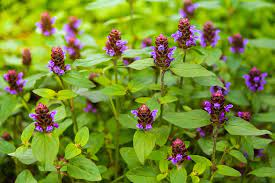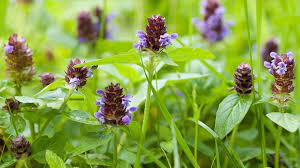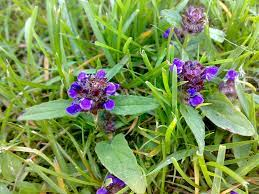Self-Heal, scientifically known as Prunella vulgaris, is a versatile and resilient herbaceous perennial plant that belongs to the mint family, Lamiaceae. Widely distributed across Europe, Asia, and North America, this herb is recognized for its historical uses in traditional medicine and its ecological significance.
Physically, Self-Heal typically grows to a height of 10 to 30 centimeters, with square stems, opposite leaves, and a cluster of tubular, two-lipped flowers arranged in dense spikes.
The flowers range in color from purple to pink and occasionally white, creating a visually striking appearance. The leaves are lance-shaped and serrated, and the entire plant is covered in fine hairs.
One of the remarkable aspects of Self-Heal is its adaptability to diverse environments, thriving in a range of habitats from meadows and woodlands to disturbed areas and lawns. This adaptability contributes to the plant’s resilience and its ability to play a stabilizing role in various ecosystems.
Historically, Self-Heal has been utilized in traditional herbal medicine for its purported healing properties. The plant contains a variety of compounds, including tannins, flavonoids, and rosmarinic acid, which are believed to contribute to its medicinal effects.
It has been employed in the treatment of various ailments, including wounds, sore throats, and gastrointestinal issues. In some cultures, it earned the name “Self-Heal” due to its association with promoting healing and well-being.
Furthermore, Self-Heal has ecological importance as a nectar source for pollinators, such as bees and butterflies. Its ability to attract beneficial insects makes it a valuable component of biodiversity, supporting the health of local ecosystems.
In contemporary times, there is a renewed interest in Self-Heal for its potential health benefits, and it is often included in herbal remedies and teas. However, as with any medicinal plant, it is essential to exercise caution and seek professional advice before incorporating it into one’s health regimen.
The Botanical Description of Self-Heal
1. Shape and Size: Self-heal (Prunella vulgaris) is a low-growing perennial herb, typically reaching a height of 6 to 12 inches. Its spreading habit forms a dense mat of foliage.
2. Leaves: The opposite leaves are lance-shaped, ranging from 1 to 2 inches in length. They are characterized by serrated edges and a slightly fuzzy texture.
3. Flowers: Self-heal produces cylindrical spikes of tubular flowers in shades of purple, pink, or lavender. The flowers are densely packed, creating a distinctive appearance.
4. Stem: The square stems of self-heal, a characteristic of the mint family (Lamiaceae), are hairy and often tinted with a reddish hue.
5. Root System: The plant has a fibrous root system that anchors it to the soil, allowing it to spread and form colonies.
6. Blooming Period: Self-heal typically blooms from late spring to early fall, attracting pollinators such as bees and butterflies.
7. Habitat: Commonly found in meadows, lawns, and woodland edges, self-heal is adaptable to a variety of soil conditions.
8. Aroma: When the leaves are crushed, self-heal emits a mild, pleasant aroma, characteristic of many plants in the mint family.
9. Growth Habit: Self-heal exhibits a prostrate growth habit, with its stems spreading horizontally along the ground, creating a carpet-like effect.
The Geographic Distribution of Self-Heal
1. Native Range: Self-heal is native to Europe, Asia, and North Africa, but it has become naturalized in many parts of North America.
2. North America Presence: Widely distributed in North America, self-heal can be found in grassy areas, gardens, and disturbed habitats.
3. Preferred Habitat: Thriving in a variety of habitats, self-heal is adaptable to both sunny and partially shaded locations.
4. Altitude Range: Found at varying elevations, self-heal can be encountered from lowland areas to alpine meadows.
5. Soil Preferences: Preferring well-drained soils, self-heal can tolerate different soil types, including loamy, sandy, or clayey soils.
6. Climate Adaptations: This versatile herb can withstand different climatic conditions, making it a resilient and widespread species.
7. Human Impact: Self-heal is often considered a valuable medicinal herb, and its presence in gardens contributes to its broader distribution.
8. Invasive Potential: While not typically considered invasive, self-heal can spread quickly in favorable conditions, forming dense patches.
The Chemical Composition of Self-Heal
1. Triterpenes: Self-heal contains triterpenes, compounds known for their anti-inflammatory and antioxidant properties.
2. Flavonoids: Rich in flavonoids, self-heal exhibits antioxidant and immune-boosting effects.
3. Rosmarinic Acid: A key component, rosmarinic acid contributes to self-heal’s anti-inflammatory and antimicrobial properties.
4. Phenolic Compounds: These compounds have potential health benefits, including antioxidant and anti-cancer properties.
5. Essential Oils: Self-heal produces essential oils with a variety of volatile compounds, contributing to its aromatic properties.
6. Alkaloids: While present in smaller quantities, alkaloids in self-heal may have physiological effects.
7. Glycosides: Self-heal contains glycosides, which can have various effects on the cardiovascular system.
8. Tannins: Tannins contribute to the astringency of self-heal and may have antimicrobial properties.
9. Polysaccharides: These complex carbohydrates may play a role in the plant’s immune-modulating effects.
10. Vitamins and Minerals: Self-heal contains various vitamins and minerals, contributing to its overall nutritional profile.
11. Lignans: Lignans are present in self-heal and may have antioxidant and potential anti-cancer effects.
12. Sterols: Self-heal contains sterols, plant-derived compounds with potential cholesterol-lowering properties.
Read Also: 17 Medicinal Health Benefits Of Sweet Melilot (Melilotus officinalis)
The Medicinal Health Benefits Of Self-Heal (Prunella vulgaris)

1. Anti-Inflammatory Properties: Self-heal has been traditionally used for its anti-inflammatory effects, making it valuable for conditions involving inflammation.
2. Antioxidant Support: The flavonoids and phenolic compounds in self-heal contribute to its antioxidant properties, protecting cells from oxidative stress.
3. Immune System Boost: Components like rosmarinic acid may modulate the immune system, enhancing its response to infections.
4. Wound Healing: Self-heal has been applied topically for wound healing, promoting skin regeneration and reducing inflammation.
5. Respiratory Health: Traditionally used for respiratory conditions, self-heal may provide relief for coughs and congestion.
6. Cardiovascular Support: Certain compounds in self-heal, such as sterols, may contribute to cardiovascular health.
7. Antimicrobial Action: The presence of tannins and essential oils gives self-heal antimicrobial properties, making it effective against certain pathogens.
8. Gastrointestinal Comfort: Triterpenes and glycosides in self-heal may contribute to soothing effects on the gastrointestinal tract.
9. Stress Reduction: The aromatic properties of self-heal may have a calming effect, aiding in stress reduction.
10. Anti-Cancer Potential: Some studies suggest that self-heal’s compounds, including lignans, may have anti-cancer potential, though more research is needed.
11. Liver Health: Preliminary research indicates that self-heal may have a positive impact on liver health, potentially supporting detoxification.
12. Diabetes Management: Flavonoids in self-heal may assist in managing diabetes by influencing glucose metabolism.
13. Antiviral Effects: Compounds in self-heal have been studied for their potential antiviral effects, suggesting a role in viral infection prevention.
14. Anxiety Relief: The calming effects of self-heal may extend to anxiety relief, providing a natural option for stress management.
15. Allergy Support: Some individuals use self-heal for allergy relief, attributing its effects to anti-inflammatory and immune-modulating properties.
16. Cognitive Function: Preliminary studies suggest that self-heal may have positive effects on cognitive function, though more research is needed.
17. Antispasmodic Action: Traditional use includes self-heal’s antispasmodic properties, providing relief for muscle spasms and tension.
18. Skin Conditions: Topical applications of self-heal may benefit various skin conditions, including eczema and dermatitis.
19. Diuretic Effects: Self-heal’s diuretic properties may aid in promoting fluid balance and urinary tract health.
20. Joint Comfort: Anti-inflammatory compounds in self-heal may contribute to joint health, providing relief for conditions like arthritis.
The Methods of Usage to Achieve the Provided Health Benefits Of Self-Heal (Prunella vulgaris)
1. Herbal Teas: Prepare herbal teas using self-heal leaves and flowers for respiratory health, stress reduction, and immune support.
2. Tinctures: Tinctures made from self-heal extracts provide a concentrated form of the herb for various health benefits.
3. Poultices: Apply crushed self-heal leaves as poultices for wound healing, skin conditions, and localized relief.
4. Salves and Ointments: Topical applications of self-heal-infused salves and ointments for skin issues and joint comfort.
5. Culinary Uses: Incorporate fresh self-heal leaves into salads or use them as a garnish for a mild herbal flavor.
6. Capsules and Supplements: Convenient consumption of self-heal in capsule or supplement form for targeted health benefits.
7. Aromatherapy: Utilize self-heal essential oils in aromatherapy for stress reduction, anxiety relief, and a calming atmosphere.
8. Infused Oils: Create infused oils using self-heal for topical applications, massage, and skin health.
9. Steams and Inhalations: Inhale steam infused with self-heal for respiratory health and relief from congestion.
10. Herbal Combinations: Combine self-heal with other complementary herbs for synergistic effects in herbal formulations.
The Side Effects Of Using Self-Heal Medicinal Plant
1. Allergic Reactions: Some individuals may experience allergic reactions to self-heal, especially if sensitive to plants in the mint family.
2. Gastrointestinal Distress: Excessive consumption may lead to nausea or stomach upset, particularly in sensitive individuals.
3. Photosensitivity: Topical use of self-heal essential oil may increase sensitivity to sunlight; use caution during sun exposure.
4. Drug Interactions: Self-heal supplements may interact with certain medications, particularly those affecting blood clotting.
5. Pregnancy and Breastfeeding: Pregnant or breastfeeding individuals should consult healthcare professionals before using self-heal due to potential effects on pregnancy.
6. Sedation: Some people may experience mild sedation after using self-heal, affecting alertness and concentration.
7. Blood Sugar Impact: Monitor blood sugar levels, especially for individuals with diabetes, as self-heal may influence glucose metabolism.
8. Liver Conditions: Individuals with existing liver conditions should exercise caution, as self-heal may impact liver health.
9. Respiratory Sensitivity: Rare cases of respiratory sensitivity to self-heal vapors or dust have been reported.
10. Not Suitable for Children: Certain formulations may not be suitable for children; follow age-appropriate dosages and consult with healthcare professionals.
11. Kidney Health: Individuals with kidney conditions should use self-heal with caution, as diuretic effects may influence kidney function.
12. Hypotensive Effects: Self-heal may have hypotensive effects; those with low blood pressure should use it cautiously.
13. Blood Clotting Disorders: Individuals with blood clotting disorders should avoid self-heal or use it under medical supervision due to potential interactions.
Read Also: Importance and Different Uses of Oranges
The Scientific Research and Studies of Self-Heal (Prunella vulgaris)

1. Anti-Inflammatory Effects: Scientific studies support self-heal’s traditional use for its anti-inflammatory effects, suggesting potential benefits for inflammatory conditions.
2. Antioxidant Activity: Research indicates that self-heal exhibits antioxidant activity, protecting cells from oxidative damage.
3. Immune Modulation: Studies explore the immune-modulating effects of self-heal, suggesting positive influences on immune system function.
4. Wound Healing Properties: Scientific investigations validate self-heal’s wound healing properties, supporting its traditional topical use.
5. Respiratory Benefits: Research explores the respiratory benefits of self-heal, indicating potential relief for respiratory conditions.
6. Cardiovascular Implications: Studies investigate cardiovascular implications, hinting at potential benefits for heart health.
7. Antimicrobial Action: In vitro studies suggest that self-heal has antimicrobial properties, making it effective against certain pathogens.
8. Gastrointestinal Impact: Clinical research explores the impact of self-heal on gastrointestinal health, indicating potential relief for discomfort.
9. Stress Reduction: Preliminary studies suggest that self-heal may have stress-reducing effects, potentially influencing cortisol levels.
10. Anticancer Potential: Some compounds in self-heal, such as rosmarinic acid and lignans, are subjects of research for their potential anticancer effects.
11. Cognitive Effects: Limited studies suggest potential positive effects on cognitive function, though more research is needed.
The Safety Precautions and Recommendations In Using Self-Heal (Prunella vulgaris)
1. Consultation with Healthcare Professionals: Before using self-heal for medicinal purposes, especially if pregnant, breastfeeding, or under medical treatment, consult with healthcare professionals.
2. Dosage Guidelines: Follow recommended dosages provided by healthcare professionals or product labels to avoid adverse effects.
3. Monitoring Blood Sugar Levels: Individuals with diabetes should monitor blood sugar levels when using self-heal due to potential effects on glucose metabolism.
4. Avoiding Excessive Use: Refrain from excessive consumption of self-heal to prevent potential side effects, especially in sensitive individuals.
5. Allergy Testing: Conduct allergy tests before using self-heal, particularly if there is a known sensitivity to plants in the mint family.
6. Age Considerations: Use caution with children, following age-appropriate dosages and seeking guidance from healthcare professionals.
7. Photosensitivity Precautions: Be aware of potential photosensitivity when using self-heal topically; take precautions during sun exposure.
8. Understanding Sedation: Be mindful of potential mild sedation after using self-heal, affecting alertness and concentration.
9. Kidney Function Monitoring: Individuals with kidney conditions should monitor kidney function when using self-heal due to diuretic effects.
10. Blood Pressure Awareness: Those with low blood pressure should use self-heal cautiously, as it may have hypotensive effects.
11. Blood Clotting Disorders: Individuals with blood clotting disorders should avoid self-heal or use it under medical supervision.
12. Liver Health Monitoring: Individuals with existing liver conditions should use self-heal with caution and seek medical advice if needed.
FAQs About Self-Heal Medicinal Plant
1. Can self-heal be grown at home?
Yes, self-heal can be cultivated in home gardens. It is a hardy and adaptable plant that thrives in various conditions.
2. Is self-heal invasive?
Self-heal is not typically considered invasive, but it can spread quickly in favorable conditions. Regular monitoring and control measures may be necessary.
3. Can self-heal be used for anxiety relief?
The calming effects of self-heal may contribute to anxiety relief, making it a potential option for stress management.
4. Is self-heal safe for pregnant individuals?
Pregnant individuals should consult healthcare professionals before using self-heal due to potential effects on pregnancy.
5. Can self-heal be used for children’s health?
Certain formulations may be suitable for children, but it’s essential to follow age-appropriate dosages and seek guidance from healthcare professionals.
6. How long does it take to see the effects of self-heal on wound healing?
The time it takes to see the effects of self-heal on wound healing can vary. Consistent and proper application is key, with results typically visible over time.
7. Can self-heal be used for chronic conditions?
Self-heal may offer support for chronic conditions,
but it’s crucial to consult with healthcare professionals for comprehensive management and guidance.
8. Can self-heal be used for respiratory issues in children?
While self-heal has been traditionally used for respiratory issues, it’s important to consult with pediatric healthcare professionals for safe and effective use in children.
9. Can self-heal be used in conjunction with conventional medications?
Inform healthcare professionals about the use of self-heal when taking conventional medications to ensure compatibility and avoid potential interactions.
10. Is self-heal safe for long-term use?
The safety of long-term use depends on individual health conditions. Consult with healthcare professionals for personalized advice on the duration of self-heal usage.
11. Can self-heal be applied topically for skin conditions in pets?
The use of self-heal for pets should be approached cautiously. Consult with a veterinarian before applying self-heal products to pets for skin conditions.
12. Can self-heal be used in culinary preparations?
Yes, fresh self-heal leaves can be used in culinary preparations like salads or as a garnish to impart a mild herbal flavor.
13. How does self-heal influence cognitive function?
Limited studies suggest potential positive effects on cognitive function, but more research is needed to fully understand the mechanisms and extent of these effects.
14. Can self-heal be used for joint pain relief?
Anti-inflammatory compounds in self-heal may contribute to joint health, offering potential relief for conditions like arthritis.
15. Are there specific contraindications for using self-heal during surgery?
Individuals planning surgery should inform healthcare professionals about self-heal usage, as it may interact with medications used during surgical procedures.
16. Can self-heal be used for respiratory sensitivity issues?
Rare cases of respiratory sensitivity to self-heal vapors or dust have been reported, so individuals with respiratory sensitivity should exercise caution.
17. Can self-heal be used for hair and scalp health?
While there is limited evidence, the antioxidant and anti-inflammatory properties of self-heal may contribute to hair and scalp health. Consult with dermatologists for personalized advice.
Read Also: What to Know About Kokedama

